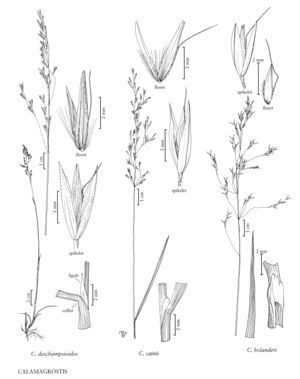Difference between revisions of "Calamagrostis bolanderi"
FNA>Volume Importer |
imported>Volume Importer |
||
| (7 intermediate revisions by 2 users not shown) | |||
| Line 4: | Line 4: | ||
|publications= | |publications= | ||
|common_names=Bolander's reedgrass | |common_names=Bolander's reedgrass | ||
| + | |special_status={{Treatment/ID/Special_status | ||
| + | |code=E | ||
| + | |label=Endemic | ||
| + | }} | ||
|basionyms= | |basionyms= | ||
|synonyms= | |synonyms= | ||
| Line 26: | Line 30: | ||
-->{{#Taxon: | -->{{#Taxon: | ||
name=Calamagrostis bolanderi | name=Calamagrostis bolanderi | ||
| − | |||
|authority=Thurb. | |authority=Thurb. | ||
|rank=species | |rank=species | ||
| Line 33: | Line 36: | ||
|basionyms= | |basionyms= | ||
|family=Poaceae | |family=Poaceae | ||
| + | |illustrator=Cindy Roché;Hana Pazdírková | ||
| + | |illustration copyright=Utah State University | ||
|distribution=Calif.;Oreg. | |distribution=Calif.;Oreg. | ||
|reference=None | |reference=None | ||
|publication title= | |publication title= | ||
|publication year= | |publication year= | ||
| − | |special status= | + | |special status=Endemic |
| − | |source xml=https:// | + | |source xml=https://bitbucket.org/aafc-mbb/fna-data-curation/src/200273ad09963decb8fc72550212de541d86569d/coarse_grained_fna_xml/V24/V24_1016.xml |
|subfamily=Poaceae subfam. Pooideae | |subfamily=Poaceae subfam. Pooideae | ||
|tribe=Poaceae tribe Poeae | |tribe=Poaceae tribe Poeae | ||
Latest revision as of 17:21, 11 May 2021
Plants sometimes with sterile culms; mostly cespitose, with rhizomes to 3 cm long, 1-2 mm thick. Culms 50-150 cm, un¬branched, smooth or slightly scabrous beneath the panicles; nodes 2-4. Leaves distributed along the culms; sheaths and collars smooth or scabrous, glabrous; ligules (2)3(5) mm, more or less obtuse, entire to lacerate; blades (5)15-26(30) cm long, (2)3-7(10) mm wide, flat or involute, smooth or slightly scabrous, glabrous or sparsely hairy. Panicles (4)10-16(25) cm long, (2.5)4-5.5(6) cm wide, open, erect to nodding, pale green to bronze or purple; branches (4)5.5-8(9) cm, sparsely scabrous, spreading to ascending, spikelets confined to the distal 1/4-1/2. Spikelets 3-4(5) mm; rachilla prolongations 0.5-1 mm, hairs 1-1.5 mm. Glumes rounded to slightly keeled, keels scabrous distally, lateral veins obscure, apices acute; callus hairs 0.5-1 mm, 0.2-0.4 times as long as the lemmas, appearing sparse primarily because of their shortness; lemmas 2.5-3 mm, 0-1(2) mm shorter than the glumes; awns 3.5-5(6) mm, attached to the lower 1/10 – 1/5 of the lemmas, usually exserted, strongly bent; anthers (1.5)2-3 mm. 2n = 56.
Discussion
Calamagrostis bolanderi grows in marshes, swamps, bogs, fens, seeps, moist meadows, open and closed coniferous and broadleaf forests, prairies, and coastal scrub, from sea level to 500 m. It is known only from sites near the coast in Humboldt, Mendocino, and Sonoma counties, California. It differs from C. breweri and C. muiriana in having leaves evenly distributed along the culms.
Selected References
None.
